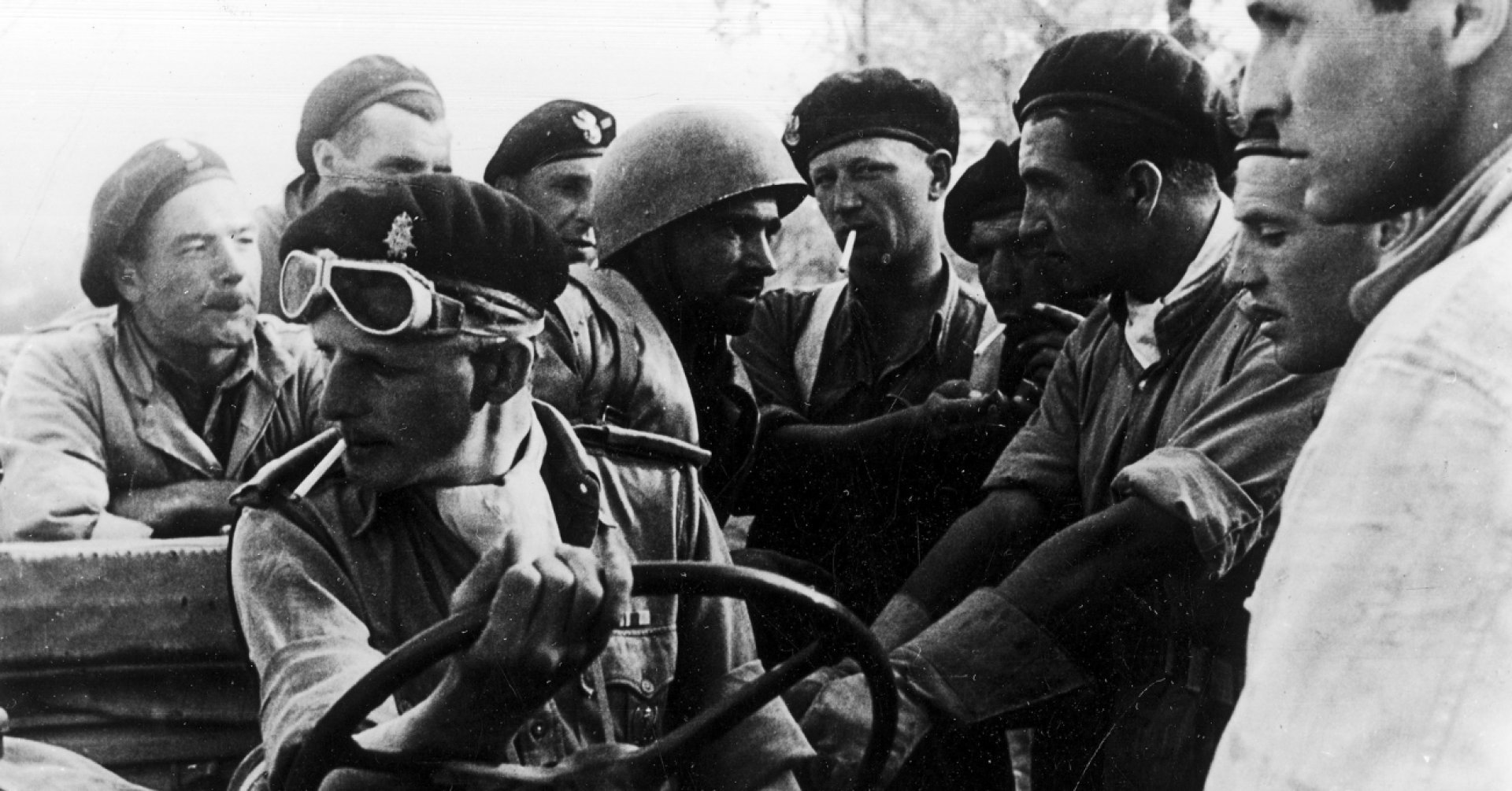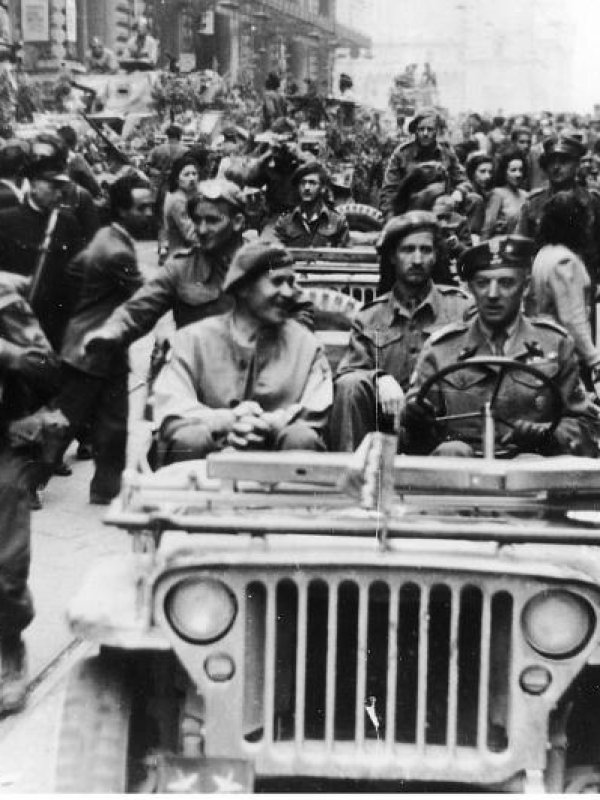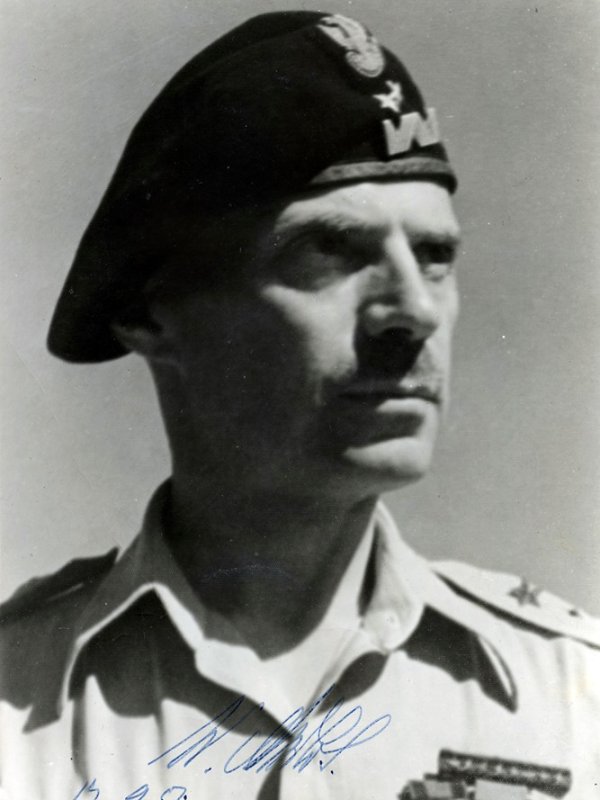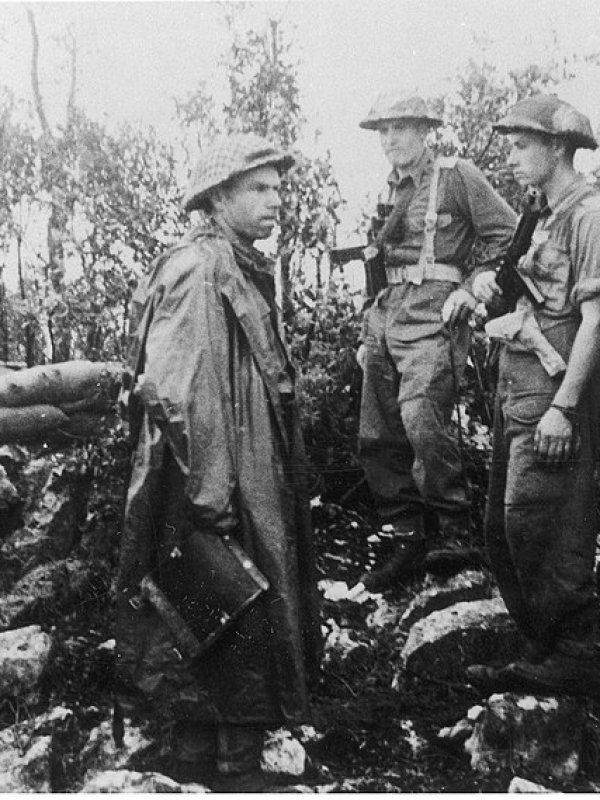2nd Polish Corps: ‘We were united by the blood we shed together’
reading time:

It was the largest tactical unit of the Polish Armed Forces in the West, its battles have become the stuff of legend and its commander is regarded as one of the most important figures in 20th-century Polish history. On 21 July 1943, the 2nd Polish Corps under the command of General Władysław Anders was established in Iraq.
Its roots can be traced back to the early months of the Second World War, when the idea of an Allied offensive against the Third Reich from the southern direction, i.e. through the Balkans, was born. The possible threat of a clash with the USSR in the Middle East and the Caucasus could also be envisaged.
The Commander-in-Chief of the Polish Armed Forces, General Władysław Sikorski, saw in such scenarios the possibility of reaching Polish territory more quickly, so he strove to form Polish units in this part of the world. However, due to the scarcity of human resources only the Independent Carpathian (Karpacka) Rifle Brigade could be formed.
The Commander-in-Chief of the Polish Armed Forces, General Władysław Sikorski, saw in such scenarios the possibility of reaching Polish territory more quickly, so he strove to form Polish units in this part of the world. However, due to the scarcity of human resources only the Independent Carpathian (Karpacka) Rifle Brigade could be formed.
The situation changed after July 1941. The German attack on the Soviets and the signing of the Sikorski-Mayski Agreement made it possible to create an army led by General Władysław Anders with Poles in the USSR. Several tens of thousands of soldiers were successfully assembled. Supply problems, disagreements over the concept of using Polish units and Stalin’s increasingly hostile policy towards the Polish Government-in-Exile, however, led to soldiers being moved out of the USSR to the Middle East.
The first evacuation of surplus troops to Persia took place at the turn of March and April 1942. As a result, for the first time in this part of the world, the Polish 2nd Rifle Corps was established under the command of Major General Józef Zajac. It was to be the counterpart of the 1st Corps, stationed in Scotland and intended to fight alongside the Allies in Western Europe, in operations in the Middle East and the Mediterranean.
Further Polish-Soviet tensions and a proposal to transfer Poles to protect the British-controlled Iraqi oil fields led to a second evacuation of the Polish Army in the USSR in late August/early September 1942. In total, over 78,000 soldiers and 37,000 civilians were moved to Persia. On 12 September, the Commander-in-Chief established the Polish Army in the East (Polish acronym: APW) under the command of General Anders. This entailed the liquidation of the 2nd Rifle Corps, but as it turned out later - only temporarily.
Further Polish-Soviet tensions and a proposal to transfer Poles to protect the British-controlled Iraqi oil fields led to a second evacuation of the Polish Army in the USSR in late August/early September 1942. In total, over 78,000 soldiers and 37,000 civilians were moved to Persia. On 12 September, the Commander-in-Chief established the Polish Army in the East (Polish acronym: APW) under the command of General Anders. This entailed the liquidation of the 2nd Rifle Corps, but as it turned out later - only temporarily.
Rameses, The Orthodox and Lords
The core of the Polish Army in the East was made up of people brought out of the ‘inhuman land’: former prisoners and exiles who found themselves deep in the Soviet Union after 17 September 1939. The commonality of experience - of enslavement, starvation and disease or, finally, evacuation - bound these people firmly together. This was all the more so because many of their commanders had been through prisoner-of-war camps in the USSR or NKVD prisons - not only General Anders himself, but also his subordinates: General Michał Karaszewicz-Tokarzewski, General Bronisław Rakowski or Colonel Nikodem Sulik.
The second component of the Polish troops in the Middle East were the soldiers serving until recently in the Independent Carpathian Rifle Brigade, fighting from August 1941 in the defence of the Libyan fortress of Tobruk, and, after it was unlocked, participating in the victorious Battle of Gazala. In March 1942, the brigade was moved to Palestine, where, after being supplemented by evacuees from the USSR, it became the core of the 3rd Carpathian Rifle Division (Polish acronym: DSK).
The veterans of the North African campaign were called ‘Rameses’, while those evacuated from the USSR were referred to as ‘The Orthodox’. A third distinctive group consisted of ‘Lords’, or officers who had been sent to the Middle East as staff and commanders. Such was the future deputy of General Anders, General Zygmunt Bohusz-Szyszko, commander of the Independent Highland Rifle Brigade in the 1940 Norwegian campaign. But before combat experience could unite the various groups of soldiers, it became necessary to organise and train them - so that they formed a cohesive operational union ready to go to the front. The trace of these different backgrounds and experiences is reflected in the text of 'The March of the 2nd Polish Corps':
The second component of the Polish troops in the Middle East were the soldiers serving until recently in the Independent Carpathian Rifle Brigade, fighting from August 1941 in the defence of the Libyan fortress of Tobruk, and, after it was unlocked, participating in the victorious Battle of Gazala. In March 1942, the brigade was moved to Palestine, where, after being supplemented by evacuees from the USSR, it became the core of the 3rd Carpathian Rifle Division (Polish acronym: DSK).
The veterans of the North African campaign were called ‘Rameses’, while those evacuated from the USSR were referred to as ‘The Orthodox’. A third distinctive group consisted of ‘Lords’, or officers who had been sent to the Middle East as staff and commanders. Such was the future deputy of General Anders, General Zygmunt Bohusz-Szyszko, commander of the Independent Highland Rifle Brigade in the 1940 Norwegian campaign. But before combat experience could unite the various groups of soldiers, it became necessary to organise and train them - so that they formed a cohesive operational union ready to go to the front. The trace of these different backgrounds and experiences is reflected in the text of 'The March of the 2nd Polish Corps':
Maybe there were some tensions between us:
This one from Narvik, that one again an English lord,
And the third one from Tobruk,
And the fourth from Buzluk.
We were united by Monte Cassino, the monastery, the fort.
[...]
Today there is no difference between us
Today we are united by the blood we shed together,
Here lies a captain from Tobruk,
Next to him a corporal from Buzuluk,
Lying shoulder to shoulder are ‘Spruce’ and ‘Lion’.
Under Iraqi skies
Units under the command of General Anders were deployed in garrisons in Iraq - the core troops in the Khanaqin-Quizil Rabat area in the central part of the country, north of Baghdad (the command in the area of the latter village), while the 3rd DSK in the north, near Mosul and the oil fields there. In addition to carrying out infrastructure cover tasks, the APW was supposed to train.
First, however, the capabilities of the subordinate units had to be restored - it should be remembered that the soldiers who had arrived from the USSR in the months preceding the evacuation were serving in the reality of a harsh climate and shortage of supplies. The Iraqi conditions were not favourable for the arrivals from Europe either: heat (up to 50 degrees in the shade) and sandstorms were a problem. Malaria was also an issue for the malnourished and sickly soldiers - General Anders himself had contracted it in July 1943.
At the same time, the forces at their disposal were being reformed. First, the three divisions arriving from the USSR were reorganised from Soviet (regimental) to British (brigade) units. This proved to be an overstretched structure - after excluding those unable to serve and sending some evacuees from the USSR to supplement the British forces, there were just over 62,000 soldiers under General Anders' command, instead of the full-time equivalent of 71,000. Thus, some rudimentary units were liquidated, the 7th Division from the USSR became an army replenishment centre, and the 2nd Tank Brigade, formed in Palestine in the spring of 1942, was attached to the 6th Lviv (Lwowska) Infantry Division (Polish acronym: DP).
First, however, the capabilities of the subordinate units had to be restored - it should be remembered that the soldiers who had arrived from the USSR in the months preceding the evacuation were serving in the reality of a harsh climate and shortage of supplies. The Iraqi conditions were not favourable for the arrivals from Europe either: heat (up to 50 degrees in the shade) and sandstorms were a problem. Malaria was also an issue for the malnourished and sickly soldiers - General Anders himself had contracted it in July 1943.
At the same time, the forces at their disposal were being reformed. First, the three divisions arriving from the USSR were reorganised from Soviet (regimental) to British (brigade) units. This proved to be an overstretched structure - after excluding those unable to serve and sending some evacuees from the USSR to supplement the British forces, there were just over 62,000 soldiers under General Anders' command, instead of the full-time equivalent of 71,000. Thus, some rudimentary units were liquidated, the 7th Division from the USSR became an army replenishment centre, and the 2nd Tank Brigade, formed in Palestine in the spring of 1942, was attached to the 6th Lviv (Lwowska) Infantry Division (Polish acronym: DP).
While Polish units were organising themselves in Iraq, a breakthrough occurred on the war fronts. The defeat of the Germans at Stalingrad, the retreat from the Caucasus, the victory of the British at El Alamein and the landing of the Americans in French North Africa had removed the threat to the Allied oil facilities. The vision of an attack in southern Europe, in Italy and the Balkans, was becoming ever closer. And it was for this purpose that Polish troops were to be established in the Middle East.
In the first months of 1943, the Polish Army in the East was completing reorganisations of subordinate commands. In March, the 2nd Tank Brigade became independent, and the 6th Lviv DP was merged with the 5th Vilnius (Wieleńska) DP to form the 5th Borderlands (Kresowa) DP (its two brigades inherited their names from the divisions). At this time, preparations began to be made for the separation of frontline troops and rear units - the command of the latter was taken over by Brigadier General Józef Wiatr, before the war the head of work on a mobilisation plan codenamed W.
In the first months of 1943, the Polish Army in the East was completing reorganisations of subordinate commands. In March, the 2nd Tank Brigade became independent, and the 6th Lviv DP was merged with the 5th Vilnius (Wieleńska) DP to form the 5th Borderlands (Kresowa) DP (its two brigades inherited their names from the divisions). At this time, preparations began to be made for the separation of frontline troops and rear units - the command of the latter was taken over by Brigadier General Józef Wiatr, before the war the head of work on a mobilisation plan codenamed W.
‘It is we, the soldiers of the 2nd Corps’
On 27 May, a plane with General Sikorski on board landed in Cairo. The Commander-in-Chief was embarking on an inspection of troops in the Middle East, which had two objectives - to check their condition before their planned deployment to the front and to verify reports of a nascent mutiny among the officers. In the first half of June, the General visited Polish units near Kirkuk, observing demonstration exercises of the 3rd DSK and the 5th Borderlands DP. On 9 June, an army review took place and delegations of all Polish units marched in front of the Commander-in-Chief.
During his stay in the Middle East, General Sikorski also conferred with British commanders. It was then that the decision was to have been made to send a corps to the front under the command of General Anders, who also retained command of the Polish Army in the East.
On 4 July 1943, General Sikorski was killed in a Gibraltar plane crash. His successor as Commander-in-Chief was Lieutenant General Kazimierz Sosnkowski. On 9 July, the Allies landed in Sicily, thus beginning the Italian campaign. A few days later, Churchill decided to send Polish units to support the offensive on the Italian peninsula.
On 21 July, an order was issued to change the organisation of the APW. Line units became part of the 2nd Polish Corps, which was to go to Italy. The commander of British forces in the Middle East General Henry M. Wilson expressed to General Anders his expectation that the corps would reach combat readiness on 1 January 1944. In August 1943, the transport of Polish units to Palestine began, with line troops located in the Gaza area.
During this time, many soldiers of Jewish origin, influenced by Zionist agitation, deserted from the Polish army, joining the local self-defence - one of whom was the future leader of the Irgun and Israeli Prime Minister Menachem Begin. General Anders was said to have ordered the gendarmerie not to prosecute the deserters. In October, Polish divisions took part in exercises codenamed Narcissus and Verille, with emphasis placed particularly on mountain operations. In parallel, the 2nd Armoured Brigade was rearmed with Sherman-type tanks.
During his stay in the Middle East, General Sikorski also conferred with British commanders. It was then that the decision was to have been made to send a corps to the front under the command of General Anders, who also retained command of the Polish Army in the East.
On 4 July 1943, General Sikorski was killed in a Gibraltar plane crash. His successor as Commander-in-Chief was Lieutenant General Kazimierz Sosnkowski. On 9 July, the Allies landed in Sicily, thus beginning the Italian campaign. A few days later, Churchill decided to send Polish units to support the offensive on the Italian peninsula.
On 21 July, an order was issued to change the organisation of the APW. Line units became part of the 2nd Polish Corps, which was to go to Italy. The commander of British forces in the Middle East General Henry M. Wilson expressed to General Anders his expectation that the corps would reach combat readiness on 1 January 1944. In August 1943, the transport of Polish units to Palestine began, with line troops located in the Gaza area.
During this time, many soldiers of Jewish origin, influenced by Zionist agitation, deserted from the Polish army, joining the local self-defence - one of whom was the future leader of the Irgun and Israeli Prime Minister Menachem Begin. General Anders was said to have ordered the gendarmerie not to prosecute the deserters. In October, Polish divisions took part in exercises codenamed Narcissus and Verille, with emphasis placed particularly on mountain operations. In parallel, the 2nd Armoured Brigade was rearmed with Sherman-type tanks.
On 16 November, the new Commander-in-Chief, General Sosnkowski, arrived in Palestine for an inspection, in order to observe the units’ exercises and conduct briefings in the 2nd Corps command for the following weeks. The decision was also taken at that time to divide the Polish Army in the East into three units: 2nd Polish Corps, its Base, which was to serve as a recruitment and logistics base in Italy, and the units left behind in the Middle East.
Allied command was also consulted at this time on the structure of the corps. From the Allied perspective, the problem was that the Polish infantry divisions had two brigades each, rather than three like their British counterparts. The Commander-in-Chief did not agree to the reinforcement of one infantry division and the addition of British units to the corps - for political reasons, he wanted a uniformly large Polish tactical unit to fight in Italy. Ultimately, the reorganisation did not take place.
Allied command was also consulted at this time on the structure of the corps. From the Allied perspective, the problem was that the Polish infantry divisions had two brigades each, rather than three like their British counterparts. The Commander-in-Chief did not agree to the reinforcement of one infantry division and the addition of British units to the corps - for political reasons, he wanted a uniformly large Polish tactical unit to fight in Italy. Ultimately, the reorganisation did not take place.
From Sangro to Bologna
The 2nd Polish Corps was redeployed to southern Italy between December 1943 and February 1944 and incorporated into General Oliver Leese’s British 8th Army. A total of more than 48,000 soldiers, including 3,000 officers, were sent to the front. There were also 559 Women’s Auxiliary Service volunteers assigned to support operations. The core of the troops commanded by General Władysław Anders consisted of two infantry divisions: the 3rd DSK (under Brigadier General Bolesław Bronisław Duch) and the 5th Borderlands DP (under Brigadier General Nikodem Sulik), each composed of two three-battalion infantry brigades, reinforced by artillery, a reconnaissance armoured car regiment, as well as arms and service subdivisions.
The armoured fist of the Corps was formed by the 2nd Independent Armoured Brigade (under Brigadier General Bronisław Rakowski) with 164 Sherman and Stuart tanks, divided between three armoured four- squadron regiments. The corps had strong artillery, amassed in the 2nd Artillery Group. Units subordinate to the corps commander were the three-squadron reconnaissance Carpathian Uhlan Regiment, equipped with armoured cars, as well as specialist subdivisions, among them the 12th Geographical Company.
Both the corps and its subordinate units had elaborate symbolism. The identifying insignia of the entire tactical union was a white mermaid on a red background, while soldiers also wore the so-called Crusader shield on their shoulder, the 8th Army's identifying insignia - a gold cross on a white background. The symbol of the ‘Carpathian’ troops was a green spruce on a white-and-red background, while that of the ‘Borderlands’ troops a brown bison on a yellow background.
It is worth mentioning that many regiments referred to the traditions of pre-war Polish Army units, especially cavalry ones - hence the presence of the 1st Krechowce Uhlan Regiment (armoured), the 12th Podolia (Podolski) Uhlan Regiment and the 15th Greater Poland (Wielkopolski) Uhlan Regiment (reconnaissance) or the 7th Horse Artillery Regiment (self-propelled artillery).
The armoured fist of the Corps was formed by the 2nd Independent Armoured Brigade (under Brigadier General Bronisław Rakowski) with 164 Sherman and Stuart tanks, divided between three armoured four- squadron regiments. The corps had strong artillery, amassed in the 2nd Artillery Group. Units subordinate to the corps commander were the three-squadron reconnaissance Carpathian Uhlan Regiment, equipped with armoured cars, as well as specialist subdivisions, among them the 12th Geographical Company.
Both the corps and its subordinate units had elaborate symbolism. The identifying insignia of the entire tactical union was a white mermaid on a red background, while soldiers also wore the so-called Crusader shield on their shoulder, the 8th Army's identifying insignia - a gold cross on a white background. The symbol of the ‘Carpathian’ troops was a green spruce on a white-and-red background, while that of the ‘Borderlands’ troops a brown bison on a yellow background.
It is worth mentioning that many regiments referred to the traditions of pre-war Polish Army units, especially cavalry ones - hence the presence of the 1st Krechowce Uhlan Regiment (armoured), the 12th Podolia (Podolski) Uhlan Regiment and the 15th Greater Poland (Wielkopolski) Uhlan Regiment (reconnaissance) or the 7th Horse Artillery Regiment (self-propelled artillery).

The entry of the 2nd Polish Corps into Bologna: generals Zygmunt Szyszko-Bohusz (1st from the left) and Klemens Rudnicki (at the wheel) in a Willys MB car; T17 (Staghound) armored cars are visible on the left. April 21, 1945,
fot. NAC
The 2nd Polish Corps, which was the largest tactical unit of the Polish Armed Forces in the West during the Second World War, began its combat trail in the winter of 1944 with attrition warfare on the Sangro River. In May of the same year, it took part in the Battle of Monte Cassino, which made the name of the Polish soldier famous - on 18 May, a patrol from the 12th Podolia Uhlan Regiment occupied the ruins of the Benedictine monastery, which had not been captured in previous assaults.
In the following months, the Corps' combat trail took the formation through Ancona, the Line of the Goths, the Emilia Apennines and ended in April 1945 in Bologna. The Polish units were stationed in Italy until mid-1946, after which they were transported to the UK and demobilised. The vast majority of General Anders’ soldiers, like their commander, chose to emigrate after the war, as, being largely inhabitants of the eastern provinces of the Second Republic, their places of origin were now lost to the USSR.
However, their combat merits and legend were passed on to the next generation of Poles - first semi-officially in the Polish People’s Republic, then with full commitment in the post-1989 Third Republic. To this day, the ‘trail of hope’ from the USSR through Persia, Iraq, Palestine, Egypt and Italy is an important component of Polish memory of the Second World War, and General Władysław Anders or the heroes from Monte Cassino occupy a prominent place in the national canon of history.
In the following months, the Corps' combat trail took the formation through Ancona, the Line of the Goths, the Emilia Apennines and ended in April 1945 in Bologna. The Polish units were stationed in Italy until mid-1946, after which they were transported to the UK and demobilised. The vast majority of General Anders’ soldiers, like their commander, chose to emigrate after the war, as, being largely inhabitants of the eastern provinces of the Second Republic, their places of origin were now lost to the USSR.
However, their combat merits and legend were passed on to the next generation of Poles - first semi-officially in the Polish People’s Republic, then with full commitment in the post-1989 Third Republic. To this day, the ‘trail of hope’ from the USSR through Persia, Iraq, Palestine, Egypt and Italy is an important component of Polish memory of the Second World War, and General Władysław Anders or the heroes from Monte Cassino occupy a prominent place in the national canon of history.
Background photo: General Władysław Anders among Polish soldiers from Tadeusz Szumański’s Photographic Archive / National Digital Archives
RelatedMaterials
Articles

Articles
explore






